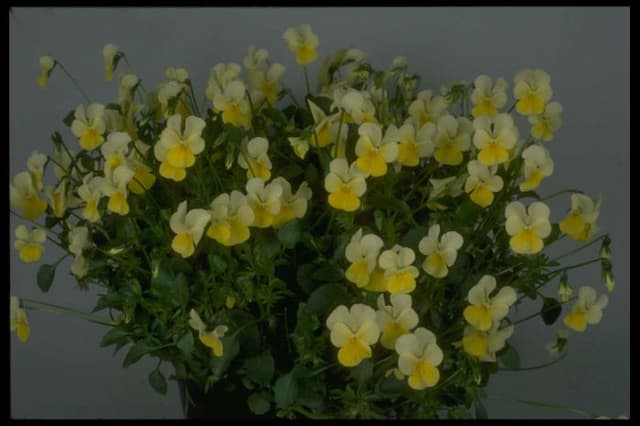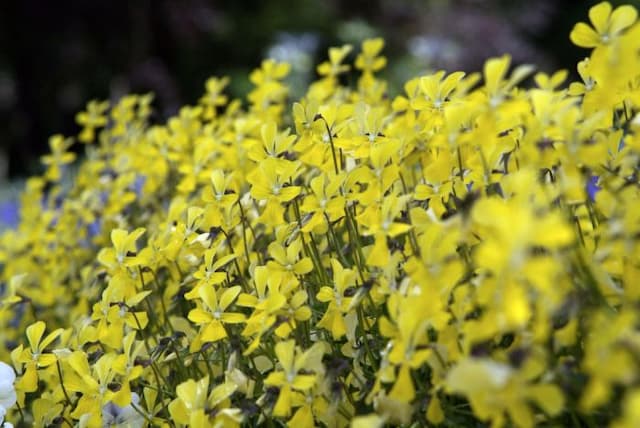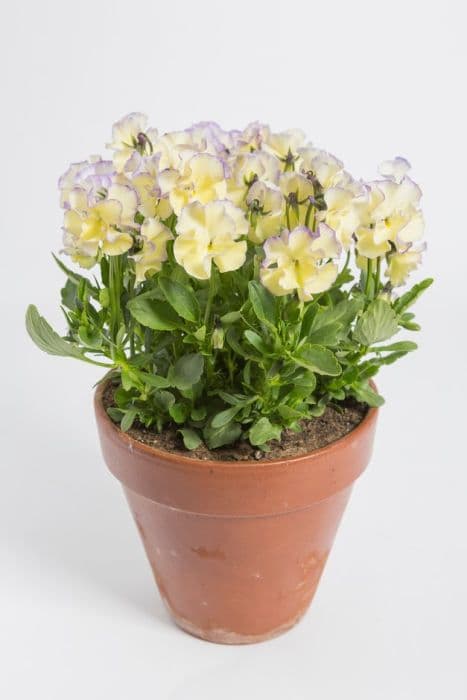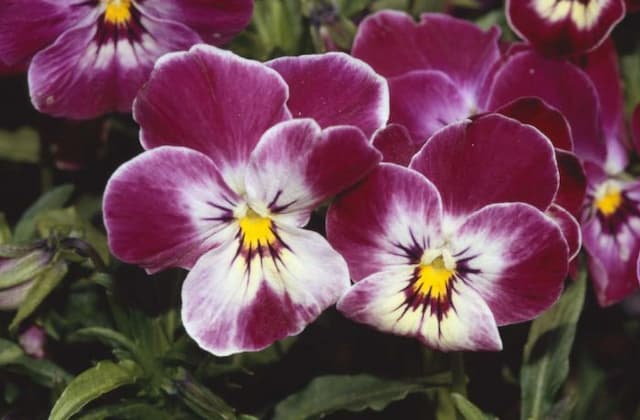Johnny Jump Up Viola tricolor

ABOUT
The Viola tricolor, commonly known as Johnny Jump Up or heartsease, is a charming flowering plant. It is renowned for its vibrant and colorful flowers, which typically feature a delightful combination of purple, yellow, and white hues with bold, velvety petals. These flowers resemble little cheerful faces and have five petals in total; the lower petal often has dark lines that serve as nectar guides for pollinators. The blooms boast a symmetrical design with two upper petals, two side petals, and one central lower petal. The foliage of Johnny Jump Up is equally attractive, comprising small, green, heart-shaped leaves that are sometimes slightly toothed at the edges. The leaves are arranged alternately on slender, green stems that are slightly angular and have a tendency to sprawl or climb modestly over the surrounding ground or nearby plants. Despite its delicate looks, the Johnny Jump Up is quite hardy and can bloom from spring into late fall, offering a prolonged display of its cheerful flowers. This plant is versatile and often found in gardens, where it provides a quaint, cottage-like charm with its freewheeling growth and profuse, whimsical flowers.
About this plant
 Names
NamesFamily
Violaceae.
Synonyms
Heartsease, Johnny Jump Up, Wild Pansy, Hearts Delight, Tickle-my-fancy, Come-and-cuddle-me, Three Faces In A Hood, Love-in-idleness, Jack-jump-up-and-kiss-me, Heart's Ease.
Common names
Viola arvensis Murray, Viola tricolor var. arvensis (Murray) Gaudin, Viola tricolor var. tricolor.
 Toxicity
ToxicityTo humans
The plant commonly known as Johnny Jump Up (Viola tricolor) is not generally considered toxic to humans. As a matter of fact, some parts of the plant have been used traditionally in cooking and as a herbal remedy for various conditions. However, it is important to note that consuming any plant material can potentially cause a reaction in sensitive individuals or when ingested in large amounts. Such reactions can range from gastrointestinal discomfort such as nausea, vomiting, and diarrhea to allergic reactions. Always consult with a healthcare professional before using any plant medicinally.
To pets
Johnny Jump Up (Viola tricolor) is not generally recognized as a toxic plant to pets. While not commonly associated with severe toxicity, pets may still experience mild gastrointestinal upset if they consume a large quantity of the plant. Symptoms such as vomiting, diarrhea, and drooling can occur. Always monitor your pets around plants and consult with a veterinarian if you observe any signs of distress after ingestion.
 Characteristics
CharacteristicsLife cycle
Annuals
Foliage type
Deciduous
Color of leaves
Green
Flower color
Mixed
Height
6 inches (15 cm)
Spread
9 inches (23 cm)
Plant type
Herb
Hardiness zones
4
Native area
Europe
Benefits
 General Benefits
General Benefits- Edible Flowers: Viola tricolor, commonly known as wild pansy, has edible flowers that can be used in salads, desserts, or as garnishes, adding a splash of color and a mild, sweet flavor.
- Natural Dye: The flowers of the wild pansy can be used to produce a natural dye for fabric or in crafts.
- Garden Aesthetics: With its vibrant and varied colors, wild pansy can enhance the visual appeal of gardens and landscapes.
- Attracts Pollinators: Wild pansy flowers attract beneficial pollinators like bees and butterflies, supporting local ecosystems and aiding in the pollination of other plants.
- Companion Planting: As a companion plant, wild pansy can be used to provide ground cover, suppress weeds, and potentially help deter certain pests from more sensitive plants.
- Ease of Care: Wild pansy is a hardy plant that's generally easy to care for, making it suitable for gardeners of all experience levels.
- Seasonal Flexibility: Viola tricolor can often withstand cooler temperatures and is capable of blooming in cooler seasons, providing color in the garden when other plants may not be flowering.
 Medical Properties
Medical Properties- Anti-inflammatory: Viola tricolor contains flavonoids that may reduce inflammation.
- Diuretic: It has been traditionally used to increase urine production.
- Expectorant: The plant is used to loosen phlegm in the respiratory tract.
- Demulcent: It has soothing properties that are beneficial for skin conditions and irritation.
- Vulnerary: Viola tricolor is used for its wound healing properties.
- Antimicrobial: The plant exhibits properties that can help in fighting against microorganisms.
- Mild Laxative: It has been used to gently relieve constipation.
- Respiratory Health: It is historically used to support respiratory health, particularly in cases of cough and bronchitis.
 Air-purifying Qualities
Air-purifying QualitiesThis plant is not specifically known for air purifying qualities.
 Other Uses
Other Uses- Viola tricolor, commonly known as Heartsease, can be used as a natural dye for fabric or food, yielding shades of blue to green depending on the mordant used.
- The flowers of Heartsease can be crystallized with egg white and sugar and used as decorative edibles on cakes and desserts.
- Heartsease petals can be infused in hot water to create a vibrant natural colorant for artisanal soaps.
- Dried Heartsease flowers are sometimes incorporated into potpourri mixes for their subtle fragrance and variety of colors.
- The flowers are used in the culinary arts as a garnish for salads and appetizers due to their vibrant colors and unique appearance.
- In craft activities, Heartsease blossoms can be pressed and used in botanical art or to adorn handmade paper.
- Gardeners plant Heartsease as a companion plant in vegetable gardens to attract pollinators and beneficial insects.
- The plant can be used as an indicator of soil fertility, with lush growth typically signaling nutrient-rich conditions.
- Heartsease has been traditionally used in floral arrangements to convey messages in the language of flowers, symbolizing remembrance or thoughts of love.
- The pigments extracted from Heartsease flowers can also be used to tint natural lip balms or cosmetics, providing a light color and gentle moisturizing property.
Interesting Facts
 Feng Shui
Feng ShuiThe plant Johnny Jump-up is not used in Feng Shui practice.
 Zodiac Sign Compitability
Zodiac Sign CompitabilityThe plant Johnny Jump-up is not used in astrology practice.
 Plant Symbolism
Plant Symbolism- Thoughts of Love: Viola tricolor, commonly known as Johnny Jump Up, has been historically associated with the notion of thinking of or remembering a loved one. This is partly due to its role in folklore and literature where it's often associated with tender feelings.
- Remembrance: The plant is also a symbol for remembrance, which may be linked to its use in creating herbal “love potions” during the Elizabethan era, suggesting not only love but the memory of someone special.
- Free-spiritedness: Its tendency to seed and spread easily gives it an association with a free spirit or a carefree lifestyle, much like it freely 'jumps up' in unexpected places in the garden.
 Water
WaterJohnny Jump-Ups, commonly known as Viola tricolor, should be watered regularly to keep the soil consistently moist but not waterlogged. In general, watering these plants with about one inch of water per week is sufficient. Depending on weather conditions, such as heat and wind, you might need to water them every few days, especially if they are grown in containers. It's best to water them early in the morning or late in the afternoon to reduce evaporation. During periods of rainfall, cut back on watering to prevent over-saturation of the soil.
 Light
LightJohnny Jump-Ups thrive in a spot that receives full to partial sunlight. They perform well with at least 6 to 8 hours of direct sunlight a day, but they also tolerate partially shaded locations where they can be protected from the intense heat of the afternoon sun. These flowers adapt well to a range of light conditions but flowering may be reduced in too much shade.
 Temperature
TemperatureJohnny Jump-Ups prefer cooler temperatures and perform best when daytime temperatures are between 60 to 70 degrees Fahrenheit and night temperatures are between 40 to 50 degrees Fahrenheit. They can tolerate frost and survive short periods with temperatures dipping down to around 25 degrees Fahrenheit. However, prolonged exposure to heat above 80 degrees Fahrenheit can cause the plant to become stressed or go dormant.
 Pruning
PruningPruning Johnny Jump-Ups is necessary to promote bushier growth and to encourage more blooms. Deadhead spent flowers regularly to prevent the plant from going to seed too early in the season. The best time to prune back leggy plants is in the summer to rejuvenate them for a fall bloom. Trim back about one-third of the plant to stimulate fresh growth and new flowers.
 Cleaning
CleaningAs needed
 Soil
SoilJohnny Jump Up (Viola tricolor) prefers well-draining soil rich in organic matter with a slightly acidic to neutral pH of 6.0 to 7.0. A good mix for pots would be two parts peat moss, one part perlite, and one part compost.
 Repotting
RepottingJohnny Jump Ups should be repotted every 1-2 years to refresh the soil and accommodate root growth, typically in the spring before the onset of the growing season.
 Humidity & Misting
Humidity & MistingJohnny Jump Ups favor moderate humidity levels but are generally adaptable. They do well in average room humidity but should not be subjected to extremely dry conditions.
 Suitable locations
Suitable locationsIndoor
Keep Johnny Jump Ups near a sunny window and ensure moist soil.
Outdoor
Plant Johnny Jump Ups in partial shade and keep soil moist.
Hardiness zone
Johnny Jump Ups are suitable for USDA zones 4-9.
 Life cycle
Life cycleThe life of the common pansy (Viola tricolor) begins with seed germination, which occurs in a temperature range of 15 to 20 degrees Celsius, with seeds requiring darkness to germinate. The seedlings emerge, growing two cotyledons followed by true leaves, remaining in the rosette stage for several weeks. As the plant matures, it produces a stem and develops more leaves, with the heart-shaped to oval leaves growing alternately on the stem. The pansy then flowers, typically in the spring, displaying its distinctive petals that can be purple, blue, yellow, or white. After pollination, often by insects, the plant produces fruits called capsules, containing numerous small seeds. Upon maturity, these capsules split open to release seeds into the environment, thus completing the life cycle and enabling new plants to grow.
 Propogation
PropogationPropogation time
Spring to summer
Propogation: Viola tricolor, commonly known as Johnny Jump Up, is often propagated through seed sowing. The best propagation time is during spring or fall when the soil is moist and temperatures are mild. To propagate Johnny Jump Up by seeds, scatter the seeds on the surface of a well-drained seed starting mix in a flat or container. The seeds require light for germination, so they should not be covered with soil; instead, lightly press them into the mix. Keep the soil moist but not saturated and in a location with bright, indirect sunlight. Germination usually occurs within 10 to 20 days. Once seedlings emerge and grow to a sufficient size, they can be transplanted to their final growing location, ideally spaced about 5 to 10 inches (12.7 to 25.4 centimeters) apart to allow for ample growth.









